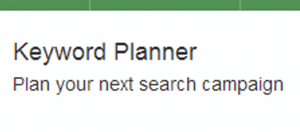I was one of many who figuratively wept when Google nixed their well-revered Keyword Tool. It had been my go-to tool for many years and was much more powerful than anything else out there (especially for free). It felt like I was losing a trusty companion!
You may also be among the many who felt this was a mistake on Google’s part. Google went so far as to redirect the old Keyword Tool URL to a “Help” page detailing the difference between the Keyword Planner and the Keyword Tool to help stave off the backlash they received.
To their credit, that was actually a good move, as it answered a lot of questions I had about the Keyword Planner and got me to try it again. What I ended up finding was that it wasn’t so bad after all.
Why Should You Use the Google Keyword Planner?
If you used the Google Keyword Tool in the past, you know the answer to this question. The Keyword Planner picks up where the Keyword Tool left off in providing keyword search data from the largest source of it – Google.
You can learn how many people search a keyword phrase each month, how much advertisers spend per click to be placed alongside the phrase’s search results, and how intense the advertiser competition is for the phrase. What this really means is you can see how lucrative a particular keyword phrase is, between volume of traffic it drives and the value of each of the visitors.
What Changed from the Keyword Tool to the Keyword Planner?
Aside from different layouts and slight differences in the process of retrieving the data and downloading it, not much really changed. The most major changes are:
- 1. No More “Match Type”: Google has replaced broad, phrase and exact match types with just exact match. Given this is what 99% of people using the tool used it for, it’s not a big deal. Some people did however look at ratios of the different match types to consider how concise a keyword phrase was, so that is no longer possible.
- 2. No More Device Targeting: People who were focused on targeting traffic from tablets and smartphones will miss this feature. However, Google does indicate they’re working on a feature to “get traffic estimates by device type and set bid adjustments for mobile devices”.
- 3. Keyword Limits Per Check Changed: So Google won’t let you manually input 2,500 keywords anymore and save the data – that limit has been reduced to 1,000 now. However, if you upload a spreadsheet with just keywords in it, you can have the tool run as many as 250,000 (!) keywords. It will only show data for 10,000 of them at a time however, but if you upload 250,000, you can run filters and assuming the end result is under 10,000, no keywords you want will be missed.
- 4. Features from the Google Traffic Estimator: This official blog post indicates some of the new features of this tool, which come from the Google Traffic Estimator. Google Adwords advertisers can make good use of features like these.
- 5. Keyword Multiplier: This is basically a tool that keyword researchers would previously use Excel to do. You can input 2 sets of keywords and combine them to form unique keyword phrases in patterns you want. For instance, you could put in the top 100 US cities in the first set and attorneys, lawyers, and law firms in the second set to generate 300 total keyword phrases. This can certainly be helpful.
- 6. You Now Must Have an Adwords Account: Before, you could use a limited version of the Google Keyword Tool without being logged in. Now, you can’t use the Keyword Planner at all without being logged in to an Adwords account. This shouldn’t be a big deal as it’s not difficult to sign up for Google Adwords.
The Verdict?
Google has a tendency to make UI changes on their tools and services that are nothing short of baffling (especially Gmail). I’m not a fan of the UI changes between the Keyword Tool and Keyword Planner. That said, the changes to what the tool actually does are pretty minor and not really a big deal. I was initially alarmed with having to use the Keyword Planner, but in the end it’s not really much worse if at all.
In fact, those like me who love to work with huge databases will love the increased keyword limit when uploading a keyword list. It may be challenging to get such huge lists to begin with, but to be able to bring one into the Keyword Planner and filter them down by criteria you’re looking for in winning keywords is definitely worth a try.
Don’t be afraid of the Keyword Planner – get used to it and you’ll find it’s not so bad after all.



